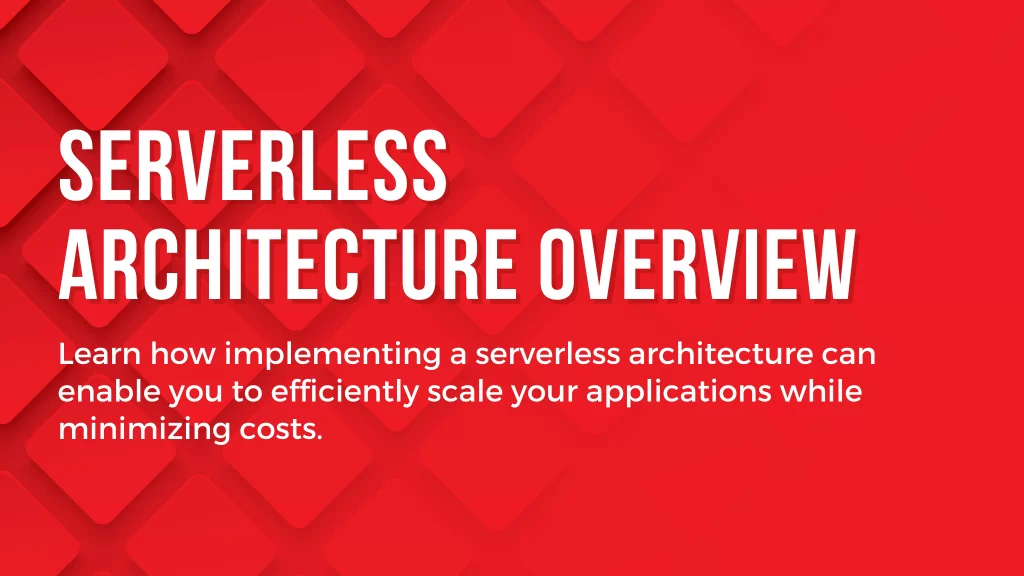
Serverless architecture is an innovative software design approach that allows developers to create and operate services without having to manage the underlying infrastructure. With this method, developers can write and deploy code, while a cloud provider provisions servers to run their applications, databases, and storage systems at any scale. This article will explore how serverless architecture functions, the benefits and drawbacks of utilizing it, and some of the tools that can aid in going serverless.
The Function as a Service (FaaS) model is one of the most prevalent serverless architectures, in which developers compose their application code as discrete functions. Each function performs a specific job when triggered by an event, such as an incoming email or an HTTP request. After undergoing testing stages, developers deploy their functions, along with their triggers, to a cloud provider account. Whenever a function is invoked, the cloud provider executes the function on a running server or spins up a new server if none is presently available. This execution process is abstracted from developers’ view, allowing them to focus on writing and deploying application code.
How Serverless Architecture Works

While servers allow users to interact with an application and access its business logic, managing them takes a significant amount of time and resources. Teams must maintain server hardware, perform software and security updates, and establish backups in case of failure. By adopting serverless architecture, developers can offload these responsibilities to a third-party provider, freeing up their time to concentrate on writing application code.
Serverless architecture has existed for over a decade, but it wasn’t until Amazon released the first mainstream Function as a Service (FaaS) platform, AWS Lambda, in 2014 that it gained widespread popularity. While most developers still use AWS Lambda to develop serverless applications, Google and Microsoft also offer their own FaaS solutions, known as Google Cloud Functions (GCF) and Azure Functions, respectively.
Fundamental Concepts in Serverless Architecture
Serverless architecture eliminates the need for server management, but using it to chain multiple functions together to create complex workflows in an application can still be challenging due to its steep learning curve. It is, therefore, helpful to familiarize oneself with the fundamental serverless concepts, such as:
Invocation: The execution of a single function.
Duration: The time taken for a serverless function to execute.
Cold Start: The latency that occurs when a function is triggered for the first time or after a period of inactivity.
Concurrency Limit: The maximum number of simultaneous function instances that can run in one region as determined by the cloud provider. If a function exceeds this limit, it will be throttled.
Timeout: The time period during which a cloud provider allows a function to run before terminating it. Most providers set a default and a maximum timeout.
It’s important to note that each cloud provider may use different terminology and have their unique limits on serverless functions, but the above list defines the basic concepts.
Serverless Architecture vs. Container Architecture
Serverless architecture and container architecture both allow developers to deploy application code while abstracting away the host environment, but there are significant differences between the two. For example, container architecture requires developers to update and maintain each deployed container, as well as its system settings and dependencies, while serverless architecture handles all server maintenance through the cloud provider. In addition, serverless applications scale automatically, whereas scaling container architecture requires an orchestration platform such as Kubernetes.
Containers provide developers with control over the underlying operating system and runtime environment, making them suitable for applications that receive consistent high traffic or as a first step in cloud migration. On the other hand, serverless functions are better suited for trigger-based events like payment processing.
Serverless Architecture: Benefits and Challenges
The use of serverless architecture has increased significantly over the years, with almost 40% of companies worldwide adopting it in some form. Both small startups and large corporations benefit from serverless architecture in the following ways:
Cost Efficiency
With serverless architecture, you only pay for the function instances you use, resulting in reduced costs compared to maintaining unused servers or virtual machines.
Scalability
Serverless architecture automatically adjusts the number of function instances in response to traffic changes, within the set concurrency limits.
Productivity
Developers using serverless architecture can focus solely on their code and application, without needing to manage servers, thus accelerating delivery cycles and improving the scalability of business operations.
However, there are also some challenges that come with serverless architecture:
Loss of Control
The software stack that your code runs on is controlled by the cloud provider. Any hardware fault, data center outage, or other issue that affects your server requires the intervention of the cloud provider.
Security
Shared servers could lead to exposure of application data, if not properly configured by the cloud provider. This is because the cloud provider could run code from several of their customers on the same server at the same time.
Performance Impact
In serverless architecture, cold starts are common and can result in additional latency, adding several seconds to the execution of code when functions are invoked after a period of inactivity.
Testing
Running integration tests to evaluate how frontend and backend components interact can be challenging in a serverless environment, even though developers can run unit tests on function code.
Vendor Lock-In
Most cloud providers offer multiple services, such as messaging queues, databases, and APIs, which are designed to work together seamlessly. Although different vendor services can be combined, services from a single provider are likely to integrate better.
Serverless architecture is most suitable for companies seeking to minimize their go-to-market time and build scalable, lightweight applications. However, virtual machines or containers may be a better choice for applications with a high number of continuous, long-running processes. Developers could adopt a hybrid infrastructure, combining containers or virtual machines to handle the bulk of requests while delegating short-running tasks like database storage to serverless functions.
Serverless Architecture Use Cases
Serverless architecture is a useful option for handling short-lived tasks and workloads with unpredictable or infrequent traffic. Below are some of the primary use cases for serverless:
Trigger-based tasks:
Any user action that triggers an event, such as a new sign-up, can be managed by a chain of serverless functions. For instance, a user sign-up might trigger a welcome email, which in turn may require a database change.
RESTful APIs:
You can scale RESTful APIs using Amazon API Gateway and serverless functions.
Asynchronous processing:
Serverless functions can handle background application tasks such as rendering product information or transcoding videos after upload without introducing user-facing latency.
Security checks:
When a new container is created, a function can be used to scan the instance for misconfigurations or vulnerabilities. Functions can also be used for more secure options for SSH verification and two-factor authentication.
Continuous Integration (CI) and Continuous Delivery (CD):
Serverless architectures can automate several stages in the CI/CD pipeline. For example, code commits can trigger a function to create a build, and pull requests can initiate automated tests.
Most developers gradually migrate to serverless by transferring some parts of their applications to serverless while keeping the remainder on traditional servers. Serverless architectures are easily scalable, so additional functions can always be added as opportunities arise.
Tools That Simplify Serverless Architecture
Using the right tools can make your transition to serverless architecture easier and ensure that your applications perform well for your users.
A serverless deployment framework like Amazon’s Serverless Application Model (SAM) or Serverless Framework allows you to define your functions, triggers, and permissions and interact with the cloud provider’s platform via an API. Providers like AWS also offer serverless testing tools that allow you to locally test serverless applications before deploying them. Serverless security tools can scan your functions for vulnerabilities and block code injections and unauthorized executables at runtime.
Once you’ve built your serverless application, it’s essential to monitor its health and performance. Serverless functions often travel through a complex web of microservices, and issues like cold starts and misconfigurations can occur at any node and cause problems across your environment. To simplify troubleshooting, real-time visibility into how each function performs, both on its own and with other infrastructure components, is necessary.
With Serverless Monitoring, you can observe the health and performance of your functions and other infrastructure components in real-time, and collect metrics, traces, and logs from every invocation. CODEPAPER supports multiple deployment frameworks and languages, so you can start monitoring your serverless architecture quickly.




